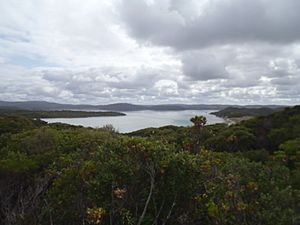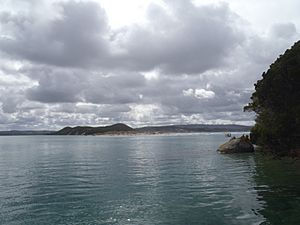Nornalup Inlet facts for kids
The Nornalup Inlet is a beautiful body of water on the south coast of Western Australia. It's about 450 kilometers (280 miles) from the city of Perth. This inlet is where fresh river water mixes with salty ocean water. It's a special place because it's home to many different plants and animals.
The inlet is quite large, covering about 1,300 hectares (3,200 acres). It can be up to 5 meters (16 feet) deep in some spots. Two rivers, the Deep River and the Frankland River, flow into it. The Nornalup Inlet is also connected to the Walpole Inlet by a natural channel. This channel is about 1 kilometer (0.6 miles) long and 2 meters (6.5 feet) deep.
The name "Nornalup" comes from the Noongar language of the local Aboriginal people. It means "the place of the tiger snake," referring to the Notechis scutatus that lives there.
Contents
What Makes Nornalup Inlet Special?
The Nornalup Inlet is unique because it's one of the few places in the South West of Australia where the river system is always open to the ocean. This constant connection helps create a rich environment for many different types of life.
Water and Land Around the Inlet
The inlet's water is mostly affected by ocean waves. While the inlet itself hasn't been changed much by people, the land around it (called the catchment area) has been cleared quite a bit. Even so, the water in the inlets is naturally clear. They are also very good at trapping sediment, which helps keep the water clean. The total area of the Walpole-Nornalup inlet system is about 15.8 square kilometers (6.1 square miles). The average depth of the inlet is about 2 meters (6.5 feet).
History and Life in the Inlet
Long ago, Aboriginal people lived around the inlets. You can still find remains of their rock fish traps there. These traps show how they used the natural resources of the area for food.
Plants and Animals
The Nornalup Inlet is home to important seagrasses. The main types found here are Ruppia megacarpa and Heterozostera tasmanica. These seagrasses provide food and shelter for many marine creatures.
Early European Visitors
European visitors started coming to the area a long time ago. Sealers, who hunted seals, were based there even before 1826. In 1831, Captain Thomas Bannister and his group also visited the inlet.
Protecting the Inlet: A Marine Park
To protect this special place, the Nornalup and Walpole inlets, along with parts of the Frankland, Deep, and Walpole Rivers, were considered for a marine park in 2006. A marine park is a protected area in the ocean or coastal waters. Today, this marine park is well-established. It helps keep the unique environment of the inlets safe for future generations.



